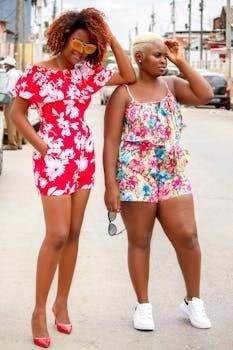Understanding Crib Shoes
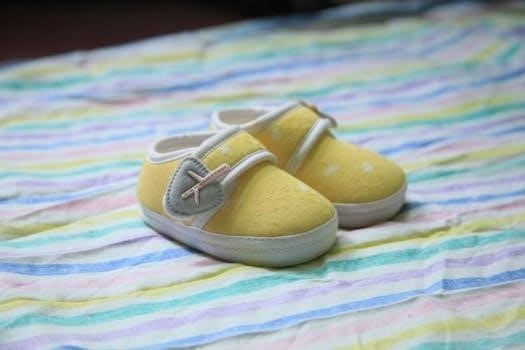
Crib shoes are designed for infants, typically from newborn to around six months old. These shoes are crafted to be lightweight, soft, and breathable. Comfort is key, ensuring a pleasant experience for the baby’s feet.
What are Crib Shoes?
Crib shoes, often referred to as pre-walking shoes, are specifically designed for infants who are not yet walking. These shoes prioritize comfort, flexibility, and breathability. Unlike shoes for older children, crib shoes are not meant to provide support for walking or running. Instead, they offer a gentle covering for delicate feet, keeping them warm and protected. The materials used are typically soft and lightweight, ensuring that they do not restrict natural foot movement. Crib shoes often feature soft soles made from fabrics or very flexible rubber, allowing the baby’s feet to develop naturally. They are not intended to offer structure or arch support, focusing instead on providing a comfortable and protective layer. Common materials include cotton, leather, or soft synthetic fabrics. Ultimately, crib shoes are designed to be gentle and non-restrictive, catering to the needs of infants who are primarily crawling, scooting, or being carried. It’s also important to ensure they have a good fit, allowing enough room for movement and growth.
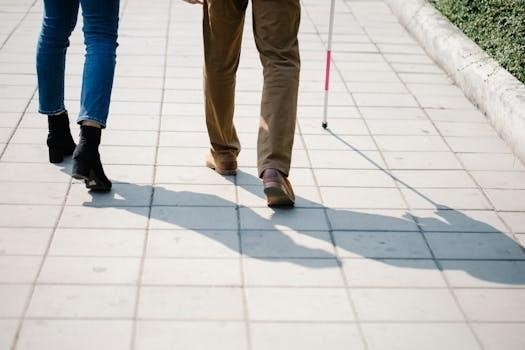
Crib Shoe Sizing by Age
Finding the right size for crib shoes involves considering age groups⁚ newborns (0-2 months), infants (2-12 months), and toddlers (12-24 months). Each stage has specific sizing needs to ensure comfort and proper fit.
Newborns (0-2 Months)
For newborns aged 0-2 months, crib shoes are primarily about keeping their tiny feet warm and comfortable rather than providing any real support for walking. At this early stage, the focus is on soft, flexible materials that won’t restrict movement or growth. Typically, shoes for newborns are lightweight and often resemble booties or soft socks with a slightly more structured sole. These shoes should be very gentle on the baby’s delicate skin, avoiding any harsh fabrics or tight elastics. Sizing for newborns is crucial, as their feet grow rapidly. It’s often best to rely on size charts provided by specific brands, as sizes can vary widely. When choosing shoes for newborns, ensure they are easy to put on and take off, as you’ll likely be changing them frequently. The primary aim is to offer a cozy and safe environment for their feet, with the understanding that they are not yet mobile. Look for breathable materials to help regulate temperature and prevent overheating. The best fit is one that allows room for growth without being too loose, avoiding any risk of the shoe slipping off.
Infants (2-12 Months)
As infants progress from 2 to 12 months, their mobility increases, though they are still not typically walking independently. Crib shoes for this age group must balance softness and flexibility with a bit more structure to support their developing feet. Look for shoes made from breathable materials that allow for natural movement. The fit should be snug but not tight, allowing room for growth. Many brands offer soft-soled shoes with non-slip features for this stage, which helps as babies begin to pull themselves up and explore their surroundings. Measuring your baby’s foot regularly is essential at this stage, as sizes can change rapidly. It’s a good practice to consult size charts specific to the brand you’re considering, as sizes can vary significantly. Consider shoes that are easy to put on and take off, as diaper changes and frequent shoe changes are common. The ideal shoe should be comfortable, not restricting, and provide a secure fit. Avoid shoes with hard or inflexible soles, as these can hinder natural foot development. The focus remains on comfort and support while allowing their feet to grow and strengthen.
Toddlers (12-24 Months)
During the toddler stage, from 12 to 24 months, children become more active and start walking. Crib shoes are no longer suitable; instead, toddlers need shoes that offer more structure and support. Look for shoes with flexible, yet durable soles that allow for natural movement while providing protection. The shoes should fit well, with enough room for toes to wiggle and grow. Measure your toddler’s feet regularly, as their size can change quickly during this period. Pay attention to both the length and width of the foot to ensure a proper fit. Choose shoes made from breathable materials to keep their feet comfortable and dry. Avoid shoes that are too stiff or heavy, as these can hinder their walking development. Non-slip soles are important to prevent falls. Consider shoes that are easy to put on and take off, promoting independence. It’s crucial to consult brand-specific size charts, as sizes vary. The primary goals are to ensure comfort, proper foot development, and safe mobility. Regularly check the fit to adjust as needed. Prioritize supportive and well-fitting footwear for your toddler’s active lifestyle.
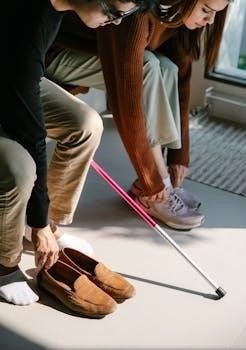
Measuring Baby’s Foot
Accurately measuring your baby’s foot is crucial for finding the right shoe size. Use a size chart, either online or from a store, to determine the correct fit. Measure regularly for best results.
Using a Size Chart
A baby shoe size chart is an essential tool for selecting the right crib shoes. These charts are readily available online or at stores selling baby shoes. Typically, a size chart correlates a child’s age or foot length with a corresponding shoe size. To use it, locate your child’s age or foot measurement on the chart’s left side and then match it with the appropriate shoe size on the right. Many charts provide measurements in both inches and centimeters. Some charts may have different categories based on the baby’s age, such as 0-6 months, 6-12 months, and so on. Ensure that you consult the specific size chart provided by the brand as infant sizes are less standardized than older children’s sizes. By following a size chart carefully, you can ensure a comfortable and proper fit for your baby’s feet, which is very important for their healthy development.
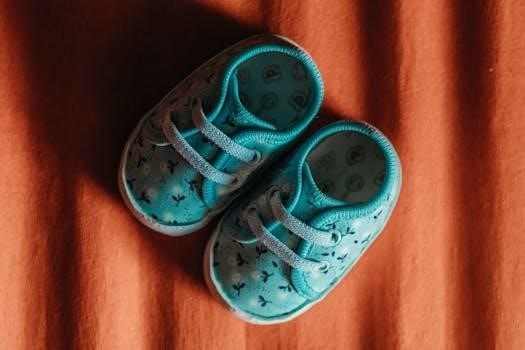
Factors to Consider
When selecting crib shoes, it’s important to consider length, width, and overall fit. If a measurement is between sizes, opt for the larger size. Always consult brand-specific charts.
Length, Width, and Fit
When choosing crib shoes, it’s crucial to consider the length, width, and overall fit to ensure your baby’s comfort and proper foot development. Unlike older children’s shoe sizes, infant sizes for crib shoes are less standardized, making it essential to measure your baby’s foot accurately. Start by measuring the length of your baby’s foot in inches or centimeters. It is important to check the specific size chart that is provided by each brand, as sizes can vary significantly. A proper fit should allow enough room for the baby to wiggle their toes freely without being too loose and causing the shoe to slip off.
The width of the shoe is also a critical factor in the shoe’s fit. A shoe that is too narrow can cause discomfort and restrict circulation, while a shoe that is too wide can cause the foot to slide around, which can be dangerous.
When in doubt, it is often recommended to choose a slightly larger size. Always ensure the shoe feels comfortable, breathable, and supportive, promoting healthy development.
Brand-Specific Charts
When selecting crib shoes, it’s vital to recognize that sizing can vary significantly between brands. Unlike standardized sizing systems for older children, infant shoe sizes often differ, making brand-specific size charts essential. Each manufacturer may have unique measurements, so relying on general sizing guides can lead to incorrect fits. Therefore, it is crucial to consult the size chart provided by the specific brand you are considering. These charts usually give measurements in inches or centimeters and help you match your baby’s foot length to the correct shoe size. Some brands even offer additional measurements for width, ensuring a more accurate fit. Always cross-reference your baby’s foot measurements with the brand’s specific chart before making a purchase. Ignoring this step can result in shoes that are either too tight or too loose, which can be uncomfortable and potentially harmful to the baby’s feet. Take the time to check each brand, as this will contribute to a better fit and the overall comfort of your baby’s shoes.
